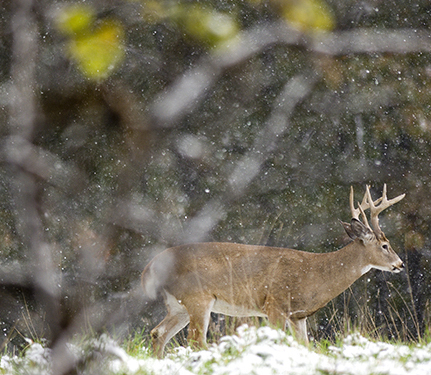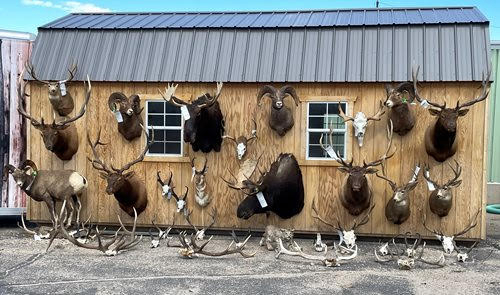Paying Dues Pays Off in Late Season Deer Hunt
By Glen Wunderlich
A self-imposed, one-buck limit meant my friend, Joe, and I were finished for the season in search of antlered whitetails. Joe had taken a fine 8-point buck during archery season and I had the same good fortune with only two days remaining in regular firearms season. Those successes would have us afield for some late-season antlerless venison.
The first Saturday of muzzleloader season – the season in which hunters no longer are required to use muzzleloaders in the southern zone of Michigan – Joe and I sat together in a blind overlooking a 6-acre field of clover with a half acre of brassicas in a small food plot. The bright sun was directly in our faces and was about a half hour before sunset, when we observed several deer entering the field somewhat over 100 yards from us. Neither of us was interested in attempting long shots, so we were content to watch the show.
To our amazement, a heavily antlered buck with headgear stretching beyond its ears in both directions began feeding with the does. For some 20 minutes the large buck mingled peacefully with the other feeding deer and both of us could only hope that the brute would survive through what was left of the deer hunting seasons. As entertaining as it was to witness such a spectacular animal as it fed in the open, we had other plans and antlers were not part of them.
As the sun sank, it became more problematic for us and kept us toward the back of the blind, where we maintained our vigil. Before long Joe whispered, “Don’t move. There’s one right in front of us.” In short order within 60 yards, one deer after another appeared from behind a stand of spruce trees. Neither of us was in position to shoot and there was no way we could move a muscle without being detected by one particular doe that was tuned in to our position. It stood right there and kept us pinned down, while the rest of the group fed. The seasoned doe kept an eye on us and without notice, decided that our presence could no longer be tolerated and led the entire group away from us into cover.
The following day, Joe brought a lady companion with him for a chance to see that big buck from the same blind we hunted the day before. I would hunt from a portable blind some 150 yards from them – one that faced the south, and therefore, not directly toward the sunshine. We wished each other luck, as I ducked into the hideout and they continued to theirs.
I zipped the shelter closed and sat on a bucket preparing for the afternoon hunt. With the zippered windows closed, I opened my backpack and got my gear ready. The sling was removed from my .450 Bushmaster rifle, the two-way radio’s earpiece was placed in my ear, my camo head net was positioned, a set of hard-shell ear muffs was put into place to soften the ear-piercing muzzle blast and a rangefinder was removed from the pack.
All of this commotion was totally hidden in the relative darkness of the blind and finally it was time to unzip the canvas window openings. A small side window was first and then a large two-zippered window in the front was next. Zip, zip. I rolled the material upward and there, not more than 45 yards, were two deer in front of me.
I did my best to line up the mature doe, but it was staring right at me. I held my motionless position waiting for the suspecting animal to look away. I finally got my chance to level the crosshairs on the deer but two factors kept me off the trigger: I didn’t want a frontal shot and the uncontrollable adrenaline rush had my heart beating like I was on a treadmill.
I had to settle the crosshairs down and the doe had to turn for the proper, broadside opportunity. A good hold and smooth trigger squeeze were the ingredients for an ethical take of another Michigan whitetail. I had paid my hunting dues, and just like that, another deer hunting season had ended





